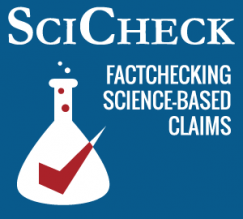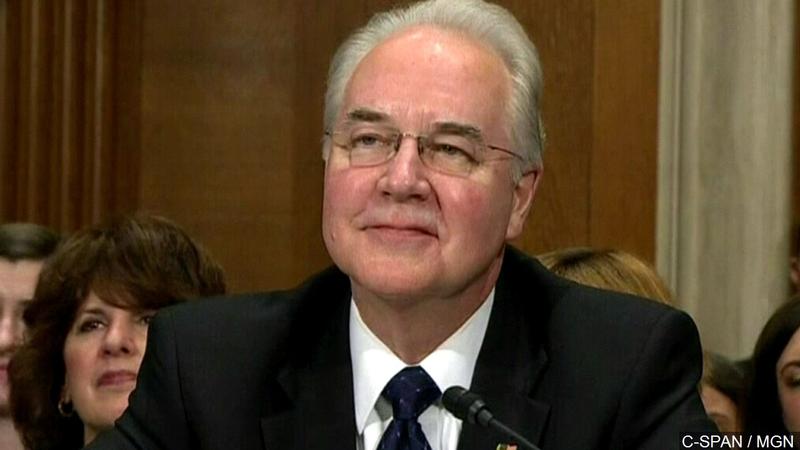Can Opioid Addiction Be Cured?
Tom Price’s claims about opioid addiction are disputed by experts.
This article was originally published at FactCheck.org as part of their SciCheck series.
Health and Human Services Secretary Tom Price made two claims about opioid addiction that are contradicted by the National Institute on Drug Abuse, which is part of the department Price heads.
Price made his claims on May 9 while in West Virginia, the state with the highest rate of opioid-related overdoses in the country.
While there is no cure for opioid addiction, medication-assisted treatments, including other opioids, “save lives” and “help to stabilize individuals, allowing treatment of their medical, psychological, and other problems so they can contribute effectively as members of families and of society,” says the NIDA.
Nationally, the rate of opioid-related deaths increased from around 3 per 100,000 people in 2000 to more than 10 per 100,000 people in 2015, according to the Centers for Disease Control and Prevention. Over 33,000 people died of opioid-related overdoses in 2015 alone. This includes both illicit opioids such as heroin and prescription opioids including oxycodone and hydrocodone.
Price visited Charleston, West Virginia, on a “‘listening tour’ that aims to gather solutions to the nation’s opioid drug crisis,” reported the Charleston Gazette-Mail. The newspaper said that Price “touted faith-based programs, while showing less support for medication-assisted programs,” when asked about drug-treatment options.
 According to experts, including the HHS’ own drug abuse agencies, substance use disorder can be successfully treated, but it can’t be cured. This is because of the way addiction affects the psychology and brain of an individual.
According to experts, including the HHS’ own drug abuse agencies, substance use disorder can be successfully treated, but it can’t be cured. This is because of the way addiction affects the psychology and brain of an individual.
First, to be diagnosed with opioid addiction, or substance use disorder more broadly, an individual must meet at least two out of 11 criteria, including developing a tolerance to a drug, experiencing withdrawal symptoms after not taking a drug and not fulfilling responsibilities because of drug use.
Developing a tolerance to opioids means the same amount of the drug will produce less of a euphoric effect. Withdrawal symptoms can include anxiety, sweating, muscle aches, diarrhea and vomiting.
After a person develops a physiological dependence on a drug, tolerance and withdrawal make it difficult to quit, Hilary Smith Connery, an expert in the treatment of opioid use disorders at Harvard Medical School, told us over the phone. But drug addiction is also a psychological disorder.
“We have no cure for substance abuse disorder in general” because it “lives” in a person’s “memories,” she told us. Even after they’ve stopped taking a drug and withdrawal symptoms subside, people have “triggers associated with the addiction process” that might cause an otherwise drug-free person to use again, she added. Triggers might include seeing a drug-using friend or a specific place where drug use took place, or being in an emotional state, such as stress or depression.
In other words, there’s “no cure” for drug addiction, “because you can’t undo memories,” Connery said.
Chronic drug-use, including opioid use, also changes the brain, experts have found.
To produce their euphoric effect, opioids affect the levels of dopamine in the brain, a chemical vital to what scientists call the reward circuitry. These neural pathways regulate a person’s motivation and incentive to repeat a certain act, let it be eating a particular food, doing a drug or having sex.
Over time, drug use can change how these neural circuits function, making it more difficult for individuals to experience pleasure without the drug, manage stress and control impulses, says the NIDA. “These changes can remain long after you stop using the drug,” adds the Mayo Clinic.

Connery also drew parallels between substance use disorder and type 2 diabetes — a comparison other researchers have made as well.
For one, like type 2 diabetes, substance use disorder doesn’t come about solely because of a person’s choices or environment — an individual’s genetics may make him or her more susceptible to addiction. Researchers have linked multiple genes to opioid addiction.
Type 2 diabetes, like substance use disorder, is also a chronic condition that can be successfully treated, but not cured.
Type 2 diabetes develops when the body can’t produce enough insulin, a hormone, or becomes resistant to insulin. But by eating healthy, exercising and potentially taking medication, the level of insulin in the body can be kept “closer to normal,” says the Mayo Clinic.
Similarly, “Overcoming an addiction and staying drug-free require a persistent effort,” explains the Mayo Clinic. As we’ll discuss in the next section, treatment for drug addiction includes taking medications, seeing a therapist or joining a support group.
Connery, who treats opioid addicts, said both type 2 diabetes and substance use disorder are “lethal,” yet doctors don’t “withhold life-saving medications” from diabetics. Access to medications for addiction patients, however, is limited.
The NIDA points out that less than half of “privately-funded substance use disorder treatment programs offer” medication-assisted treatment and a third of “patients with opioid dependence at these programs actually receive it.” The agency adds, “Nearly all U.S. states do not have sufficient treatment capacity to provide [medication-assisted treatment] to all patients with an opioid use disorder.”
Yet “the science is so clear — addicts have at least double the chance of becoming opioid-free” with medication, in particular methadone, buprenorphine and naltrexone, Connery said.
But these three medications are different. For one, methadone and buprenorphine are opioids, while naltrexone is not.
However, methadone and buprenorphine are long-acting opioids. Heroin, on the other hand, is a short-acting opioid, especially when injected intravenously.
This means methadone and buprenorphine stave off withdrawal by delivering patients a smaller amount of the opioid over time, instead of causing a strong euphoric effect by activating the dopamine pathways in the brain quickly.
In this way, doctors can ease addicts through withdrawal slowly with these medications, Connery explained.
Doctors also use methadone and buprenorphine over the long-term to prevent addicts from returning to illicit opioid use, which poses greater health risks.
For example, the NIDA cites studies that show medication-assisted treatment decreases “opioid use, opioid-related overdose deaths, criminal activity, and infectious disease transmission.”
One study, conducted by Robert P. Schwartz, the medical director of Friends Research Institute in Baltimore, and others, showed that lethal heroin overdoses decreased after buprenorphine became available in Baltimore in 2003. The average annual number of overdoses in the city was 37 percent lower for 2003 and 2009 compared with 1995 to 2002.
Published in the American Journal of Public Health in May 2013, the study’s results paralleled a study conducted in France in 2004, which also found reductions in opioid overdose deaths after the introduction of buprenorphine.
Naltrexone, which is not an opioid, helps addicts fight addiction differently than methadone and buprenorphine. It prevents a person from feeling high, even if the person does take an opioid. For this reason, it’s mainly used to prevent relapse after an addict becomes clean. As Connery explained, it “helps breaks the psychological process” because an addict knows there’s “no chance I can get high today,” even if he or she tried.
In a comment to STAT News, Alleigh Marre, Price’s spokesperson, said that in West Virginia, Price highlighted vivitrol, which is a form of naltrexone, and not an opioid, as a potential treatment. Marre said that Price supported “expanding access to treatment and recovery services, including medication-assisted treatment.” Marre also said Price was generally making the point that “what’s right for one person isn’t necessarily right for another person” when it comes to treatment for opioid addiction.
Connery agrees with Price that choosing treatment entails “looking at a particular individual, and asking questions like: Are they motivated to change? Do they have a support system? Are they court mandated to attend treatment?”
In other words, while some patients may only use behavioral therapy, other patients might use multiple medications in the course of their recovery. But overall, “it’s really not good practice, actually it’s unethical, to not offer someone” medication-assisted treatment, including methadone and buprenorphine, Connery said.
Connery elaborated on the point of individualized treatment in a review paper published in the Harvard Review of Psychiatry in March 2015.
If there is a high risk that a person will drop out of treatment, given his or her individual circumstances, the “evidence … significantly favors” using methadone because it has the “highest patient retention rates in all studies comparing methadone to buprenorphine,” Connery wrote.
On the other hand, an individual who is addicted to both opioids and alcohol “might benefit most” from naltrexone because the Food and Drug Administration has approved it as “preventing relapse to alcohol use,” in addition to opioids, she added.
But these drugs do have their downsides, Connery explained to us over the phone.
Since methadone and buprenorphine are opioids, when patients eventually decide to come off them, they could re-experience withdrawal. Some individuals might also try to “override” naltrexone’s blockage of the effect of opioids and risk overdosing, she added.
This is why treatment for opioid addiction can’t just involve these medications.
“[O]pioid abuse and dependence are most effectively treated through a set of comprehensive medical, social, psychological and rehabilitative services that address all the needs of the individual,” write Thomas F. Kresina and Robert Lubran in a review paper published in the International Journal of Environmental Research and Public Health in October 2011.
Kresina is a senior public health adviser at the Substance Abuse and Mental Health Services Administration, while Lubran is the former director of the Division of Pharmacologic Therapies at SAMHSA. Like the NIDA, SAMHSA is a branch of the Department of Health and Human Services, which Price heads.
The NIDA agrees that “[m]edications should be combined with behavioral counseling for a ‘whole patient’ approach” to treating opioid addiction.
In short, Price’s claim that “substituting one opioid for another” doesn’t move “the dial much” runs counter to the scientific evidence backing the effectiveness of methadone and buprenorphine in treating opioid addiction — evidence cited by agencies within his own department. However, Price is right that non-opioid medications such as vivitrol can help addicts recover as well.
Price also was inaccurate when he said, “Folks need to be cured so they can be productive members of society and realize their dreams.” There is no cure for drug addiction. Medication-assisted treatment, on the other hand, can “help to stabilize individuals,” eventually allowing them to “contribute effectively as members of families and of society,” writes the NIDA.